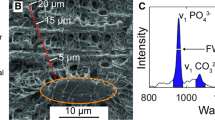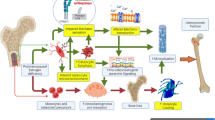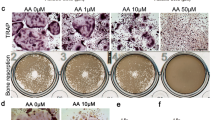Abstract
Purpose:
To study the effects of estrogen withdrawal on osteoclast number and osteoclast activity in the rat ovariectomy (OVX) model.
Methods:
We first cultured human CD34+ osteoclast precursor cells on bovine bone slices, allowing them to differentiate into mature resorbing osteoclasts. Secreted tartrate-resistant acid phosphatase 5b (TRACP 5b) and C-terminal cross-linked telopeptides of type I collagen (CTX) were determined from the culture medium. TRACP 5b correlated strongly with osteoclast number and CTX with osteoclast activity, facilitating their subsequent use in the rat OVX model. An 8 week OVX study was then performed including sham-operated rats receiving vehicle, OVX rats receiving vehicle, and OVX rats receiving 10 μg/kg/day 17β-estradiol (E2). Trabecular bone parameters were determined from the tibial metaphysis using peripheral quantitative computed tomography and histomorphometry. Osteoclast number was normalized with bone perimeter (N.Oc/B.Pm) and tissue area (N.Oc/T.Ar, indicating absolute number of osteoclasts). TRACP 5b and CTX were determined from fasting serum samples.
Results:
Trabecular bone parameters indicated substantial bone loss after OVX that was prevented by E2. N.Oc/B.Pm increased after OVX, while N.Oc/T.Ar and TRACP 5b decreased, and TRACP 5b correlated strongly with N.Oc/T.Ar. However, CTX values increased after OVX, and the “resorption index” CTX/TRACP 5b showed more substantial changes than either CTX or TRACP 5b alone.
Conclusion:
These results show that TRACP 5b is a reliable marker of osteoclast number, and the index CTX/TRACP 5b is a useful parameter in rat OVX model. The high elevation of CTX/TRACP 5b values by OVX demonstrates that estrogen withdrawal generates high activity of osteoclasts in the rat OVX model.



Similar content being viewed by others
References
Yaziji H, Janckila AJ, Lear SC, Martin AW, Yam LT (1995) Immunohistochemical detection of tartrate-resistant acid phosphatase in non-hematopoietic human tissues. Am J Clin Pathol 104:397–402
Hayman AR, Macary P, Lehner PJ, Cox TM (2001) Tartrate-resistant acid phosphatase (Acp 5): Identification in diverse human tissues and dendritic cells. J Histochem Cytochem 49:675–684
Lam WK, Eastlund DT, Li CY, Yam LT (1978) Biochemical properties of tartrate-resistant acid phosphatase in serum of adults and children. Clin Chem 24:1105–1108
Janckila AJ, Parthasarathy RN, Parthasarathy LK, et al. (2005) Properties and expression of human tartrate-resistant acid phosphatase isoform 5a by monocyte-derived cells. J Leukoc Biol 77:209–218
Lam KW, Li CY, Yam LT, Desnick RJ (1981) Comparison of the tartrate-resistant acid phosphatase in Gaucher’s disease and leukemic reticuloendotheliosis. Clin Biochem 14:177–181
Janckila AJ, Takahashi K, Sun SZ, Yam LT (2001) Tartrate-resistant acid phosphatase isoform 5b as serum marker for osteoclastic activity. Clin Chem 47:74–80
Janckila AJ, Parthasarathy RN, Parthasarathy LK, Seelan RS, Yam LT (2002) Stable expression of human tartrate-resistant acid phosphatase isoforms by CHO cells. Clin Chim Acta 326:113–122
Halleen JM, Tiitinen SL, Ylipahkala H, Fagerlund KM, Väänänen HK (2006) Tartrate-resistant acid phosphatase 5b (TRACP 5b) as a marker of bone resorption (review). Clin Lab 52:499–509
Stepan JJ, Silinkova-Malkova E, Havranek T, et al. (1993) Relationship of plasma tartrate resistant acid phosphatase to the bone isoenzyme of serum alkaline phosphatase in hyperparathyroidism. Clin Chim Acta 133:189–200
Alatalo SL, Halleen JM, Hentunen TA, Mönkkönen J, Väänänen HK (2000) Rapid screening method for osteoclast differentiation in vitro that measures tartrate-resistant acid phosphatase 5b activity secreted into the culture medium. Clin Chem 46:1751–1754
Chu P, Chao TY, Lin YF, Janckila AJ, Yam LT (2003) Correlation between histomorphometric parameters of bone resorption and serum type 5b tartrate-resistant acid phosphatase in uremic patients on maintenance hemodialysis. Am J Kidney Dis 41:1052–1059
Alatalo SL, Penq Z, Janckila AJ, et al. (2003) A novel immunoassay for the determination of tartrate-resistant acid phosphatase 5b from rat serum. J Bone Miner Res 18:134–139
Alatalo SL, Ivaska KK, Waguespack SG, Econs MJ, Väänänen HK, Halleen JM (2004) Osteoclast-derived serum tartrate-resistant acid phosphatase 5b in Albers-Schonberg disease (type II autosomal dominant osteopetrosis). Clin Chem 50:883–890
Quinn JM, Elliott J, Gillespie MT, Martin TJ (1998) A combination of osteoclast differentiation factor and macrophage-colony stimulating factor is sufficient for both human and mouse osteoclast formation in vitro. Endocrinology 139:4424–4427
Massey HM, Flanagan AM (1999) Human osteoclasts derive from CD34-positive monocytes. Br J Haematol 106:167–170
Nicholson GC, Malakellis M, Collier FM, et al. (2000) Induction of osteoclasts from CD34-positive human peripheral blood mononuclear cells by receptor activator of nuclear factor kappaB ligand (RANKL). Clin Sci (Lond) 99:133–140
Boyde A, Ali NN, Jones SJ (1984) Resorption of dentine by isolated osteoclasts in vitro. Br Dent J 156:216–220
Chambers TJ, Revell PA, Fuller K, Athanasou NA (1984) Resorption of bone by isolated rabbit osteoclasts. J Cell Sci 66:383–399
Selander K, Lehenkari P, Väänänen HK (1994) The effects of bisphosphonates on the resorption cycle of isolated osteoclasts. Calcif Tissue Int 55:368–375
Christgau S, Rosenquist C, Alexandersen P, et al. (1998) Clinical evaluation of the Serum CrossLaps One Step ELISA, a new assay measuring the serum concentration of bone-derived degradation products of type I collagen C-telopeptides. Clin Chem 44:2290–2300
Bagger YZ, Foged NT, Andersen L, Lou H, Qvist P (1999) CrossLaps for culture: An improved enzyme-linked immunosorbent assay (ELISA) for measuring bone resorption in vitro. J Bone Miner Res 14 (Suppl. 1):S370 (abstract)
Parfitt AM, Drezner MK, Glorieux FH et al. (1987) Bone histomorphometry: Standardization of nomenclature, symbols, and units. J Bone Miner Res 2:595–610
Gurkan L, Ekeland A, Gautvik KM, Langeland N, Ronningen H, Solheim LF (1986) Bone changes after castration in rats. A model for osteoporosis. Acta Orthop Scand 57:67–70
Kalu DN (1991) The ovariectomized rat model of postmenopausal bone loss. Bone Miner 15:175–191
Vanderscueren D, Van Herck E, Suiker AM, Visser WJ, Schot LP, Bouillon R (1992) Bone and mineral metabolism in aged male rats: Short and long term effects of androgen deficiency. Endocrinology 130:2906–2916
Erben RG, Eberle J, Stahr K, Goldberg M (2000) Androgen deficiency induces high turnover osteopenia in aged male rats: A sequential histomorphometric study. J Bone Miner Res 15:1085–1098
Halleen JM, Alatalo SL, Suominen H, Cheng S, Janckila AJ, Väänänen HK (2000) Tartrate-resistant acid phosphatase 5b: A novel serum marker of bone resorption. J Bone Miner Res 15:1337–1345
Hannon RA, Clowes JA, Eagleton AC, Al Hadari AA, Eastell R, Blumsohn A (2004) Clinical performance of immunoreactive tartrate resistant acid phosphatase isoform 5b as a marker of bone resorption. Bone 34:187–194
Henriksen DB, Alexandersen P, Bjarnason NH, et al. (2003) Role of gastrointestinal hormones in postprandial reduction of bone resorption. J Bone Miner Res 18:2180–2189
Halleen JM, Alatalo SL, Janckila AJ, Woitge HW, Seibel MJ, Väänänen HK (2001) Serum tartrate-resistant acid phosphatase is a specific and sensitive marker of bone resorption. Clin Chem 47:597–600
Shevde NK, Bendixen AC, Dienger KM, Pike JW (2000) Estrogens suppress RANK ligand-induced osteoclast differentiation via a stromal cell independent mechanism involving c-Jun repression. Proc Natl Acad Sci USA 97:7829–7834
Srivastava S, Toraldo G, Weitzmann MN, Cenci S, Ross FP, Pacifici R (2001) Estrogen decreases osteoclast formation by down-regulating receptor activator of NF-kappa B ligand (RANKL)-induced JNK activation. J Biol Chem 276:8836–8840
Ramalho AC, Couttet P, Baudoin C, et al. (2002) Estradiol and raloxifene decrease the formation of multinucleate cells in human bone marrow cultures. Eur Cytokine Netw 13:39–45
Sorensen MG, Henriksen K, Dziegiel MH, Tanko LB, Karsdal MA (2006) Estrogen directly attenuates human osteoclastogenesis, but has no effect on resorption by mature osteoclasts. DNA Cell Biol 25:475–483
Kameda T, Mano H, Yuasa T, et al. (1997) Estrogen inhibits bone resorption by directly inducing apoptosis of the bone-resorbing osteoclasts. J Exp Med 186:489–495
Rissanen JP, Suutari S, Ylönen S, Baugh M, Long C, Halleen JM (2005) The ratio of osteoclast activity/osteoclast number (CTX/TRACP 5b) improves the interpretation of the effects of anti-resorptive treatment in human osteoclast cultures. J Bone Miner Res 20(Suppl 1):S256
Karsdal MA, Martin TJ, Bollerslev J, Christiansen C, Henriksen K (2007) Are nonresorbing osteoclasts sources of bone anabolic activity? J Bone Miner Res 22:487–494
Henriksen K, Tanko LB, Qvist P, Delmas PD, Christiansen C, Karsdal MA (2007) Assessment of osteoclast number and function: application in the development of new and improved treatment modalities for bone diseases. Osteoporos Int 18:681–685
Acknowledgments
We thank Suvi Suutari and Salla Ylönen for their skillful technical assistance and the Finnish Funding Agency for Technology and Innovations (TEKES) for financial support.
Author information
Authors and Affiliations
Corresponding author
Additional information
Disclosure statement: Jukka Rissanen, Mari Suominen, and Zhiqi Peng have nothing to disclose; Jussi Halleen receives royalties from and works as a consultant of SBA Sciences, a company owned by IDS Ltd.
Rights and permissions
About this article
Cite this article
Rissanen, J.P., Suominen, M.I., Peng, Z. et al. Secreted Tartrate-Resistant Acid Phosphatase 5b is a Marker of Osteoclast Number in Human Osteoclast Cultures and the Rat Ovariectomy Model. Calcif Tissue Int 82, 108–115 (2008). https://doi.org/10.1007/s00223-007-9091-4
Received:
Accepted:
Published:
Issue Date:
DOI: https://doi.org/10.1007/s00223-007-9091-4




